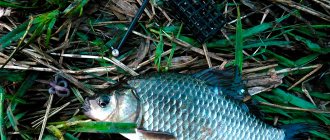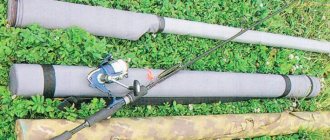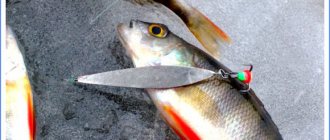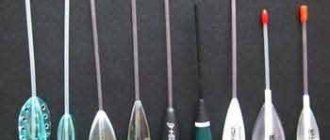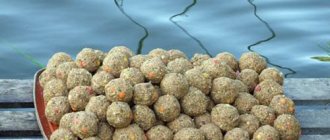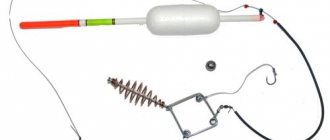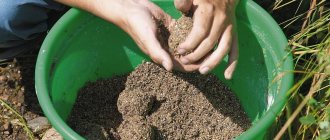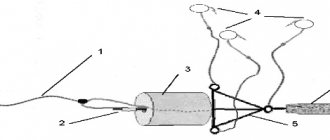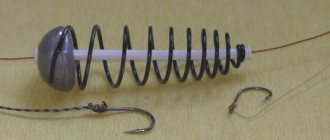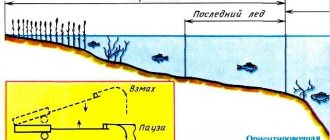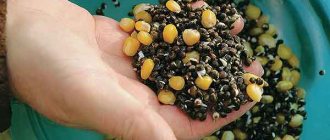One of the varieties of amateur fishing is catching carp using bottom gear, where macaque is used as a catching bait. This is an old and traditional way of catching large carp in still water, particularly in medium-sized lakes and ponds.
In many European countries, the use of makushka is prohibited, given the inhumane treatment of fish, this method is considered unsporting. But in our country, fishing for carp on the fly attracts more and more fans every year and is even elevated to the ranks of elite equipment for catching the coveted trophy.
The undeniable advantages of the makushatnik include:
- Easy to make gear.
- Affordable cost of all necessary components for installation of gear.
- High performance of the gear when catching large specimens, in particular carp.
- Anyone can make a makushatnik.
- Long service life if you strictly adhere to certain storage conditions (temperature, humidity, etc.).
- Makushatnik has excellent performance characteristics (the attractive smell of the seeds attracts fish from all over the reservoir, does not become limp in the water, and creates aromatic turbidity).
- Makushatny k can be used not only by experienced fishermen, but also by beginning carp anglers.
Despite the entire list of positive qualities, this tackle also has its negative sides, namely:
- It is classified as a poaching type of fishing.
- Injures prey.
- If there is a lead plate, casting becomes difficult.
What is a makushatnik?
Few fishermen like boring fishing, because only small fish are caught.
And you want to feel all the heaviness and activity of a large and agile fish. A makushatnik can make fishing much more interesting and active. It attracts with its simplicity and low cost. Fish hunting with it has been popular for many years. According to an old legend, once upon a time, during the Soviet era, several Soviet scientists arrived in China. There they watched for a long time how the locals caught fish. The fishing method for Soviet people seemed rather primitive, but very effective.
The principle was as follows : a piece of cake was taken, tied to a small stone and connected to a thin thread.
The whole assembly had a button attached to it. All this looked, of course, strange. But with such an unusual fishing rod, the Chinese people hunted carp, and without making any effort. The tackle was immersed in the water, and the other end was attached to the shore, and the Chinese went to work. When he returned, each time he took the fish off the tackle and went to feed his family. Our people lured this method to the USSR, where it quickly gained popularity.
When and how is it best to fish with a makushatnik?
From the experience of renowned fishermen, we can conclude that fish bite faster at night or early in the morning.
These are precisely those periods of time when there is silence and grace on the reservoirs. Note!
Balancer for perch: fishing technique and basic tactics for using the balancer (90 photos)- How to choose bed linen - instructions for beginners
Ulyanka spinner: 120 photos, drawings, instructions and video master class on creating an effective spinner
Fish carelessly swim to the shore in search of food and only then get hooked. But despite this, it is also possible to catch a lot of fish during the day, but this will most likely take more time and effort.
The main advantage of fishing with a makushatnik is the ability to fish both in still water and in good currents. And yet the results in both cases are positive.
Another advantage of this gear is the opportunity to save money. After all, the time for complete dissolution of the powder in water is about 3 hours.
Varieties of makushatniks
All makushatniks have a common principle of action - “hickey”, where the fish confuses the hook, which is located in the cake, with garbage and directs it back through the gills.
The number of hooks, the type of top , its method of fastening and the type of load are the main differences between the gear:
- A rod with a lead weight in the shape of a horseshoe , the tip is attached with a loop that tightens itself. This loop is threaded through the pulp beam. The hook is attached to the tackle using the fastener of the leader material. In such gear it is easy to change the hook or add a few more leashes.
- Tackle with a lead weight in the shape of a heart , the top is attached with a loop that tightens itself. The cake is shaped like a cylinder and a loop is wrapped around it. A leash with hooks is tied to the load with a simple knot. Replacing the hook when necessary is quite difficult and time-consuming. In areas with fast flows, this gear is not used.
- The third type of tackle is considered the most popular, as it is based on a flat square lead sinker with a side . The thrust board protects the cake from crumbling in case of collisions with anything in the water. Also, the flat shape of the load allows it to always be above the bottom. The crown is tightened with a loop with a ring. Hooks are inserted into the holes made.
- Tackle of a combined design , which is supplemented with a feeder where complementary foods are placed. This type of gear attracts carp the most.
Photo of the makushatnik
Read here DIY ice drill: life hacks, drawings and tips for choosing a design. Assembly and use instructions (140 photos + video)
Help the project, share on social networks
0
The essence of the fishing method
Today, button fishing has a different name - makushatnik. The button, naturally, was replaced by a hook. This device is a rather heavy weight with a latch or elastic band that holds the “makuha” - seed cake - on the load. Several leashes with hooks are attached to the load and stuck into the cake.
Fishing on top is as follows:
- The makushatnik is thrown into the water
- Sunflower, hemp or flax (cake) begins to swell in water and attract fish with its aroma.
- The fish, absorbing the swollen food, grabs the hook accordingly.
- If the leashes with hooks are long enough, then the fish tries to throw the hook through the gills, which it succeeds in doing. If the leash is short, then the hook cannot be thrown out, so the fish’s lip is pierced.
After casting the top, you should not wait for an instant bite, since the process of soaking and stratification of the food is quite long.
If the line tightens sharply and the reel clicks, it means a bite has occurred; it is impossible not to notice it.
You need to hook the fish instantly and sharply, since a large trophy has very dense tissue on its lips.
Design and principle of operation of the gear
The classic makushatnik (otherwise known as a press-on) is a tackle based on a flat load (usually a lead plate). Leashes with hooks are attached to the load, which are subsequently inserted into the bait. In this case, it is a piece of makukha - pressed cake left after processing the seeds into oil. It is attached to the sinker in various ways: with an elastic band, a bolt, a screw, and so on.
Carp feed by filtering water through their gills. It swims to the source of the fragrance and sucks in the hooks along with the muddy nutrient water. In most cases, self-hooking follows, and the fisherman can only pull the desperately resisting prey to the shore.
Advantages and disadvantages
The advantages of this fishing method include:
Among the objective disadvantages of this method, increased requirements for other equipment elements should be noted. All components must be highly durable, but when fishing for carp, this rule must always be observed, regardless of the tactics and method of fishing.
Fishing with a classic makushatnik cannot be called a sport fishing method - high trauma to fish is almost inevitable. But we don’t fish in order to immediately release the trophies, they will still end up in the frying pan. However, if you wish, you can mount a sports type of equipment, with one leash, and fish almost in accordance with the canons of the high art of carp fishing.
Equipping a donkey with a top cover
As a rule, the bait is caught using a donkey with a rod, but sometimes it is included in the equipment of a mug or hook. Let's consider the design of a classic bottom fishing rod equipped with a top rod.
Making classic tackle
We remind you that, if desired, a ready-made carp shell of the required weight can be purchased at a fishing store, but you can also make it yourself. The stages of work on the gear look like this:
Variety of designs
Professionals in carp fishing use various designs of fishing rods, sometimes far from the classical parameters. Only one point remains unchanged: mounting the crown on a heavy plate.
Among the most interesting finds are:
A special variation of the tackle is the maw feeder . In this case, a ring with a feeder for soft food (“method”, “spring”, etc.) is attached to the load from behind. The main negative point is that the tackle becomes heavier, but the accuracy and casting range increases, and the cloud of turbidity that is tempting for fish reaches maximum concentration.
Bait selection
Pieces of pressed cake are used as bait. Any meal will do (rapeseed, corn, flaxseed, hemp), but usually carp prefer sunflower meal. Often, fishermen buy cake wheels at the market and then independently cut them into bars or cubes in accordance with the parameters of their own gear.
Making makukha at home
Choice of time and place
It should be remembered that the period of active biting in summer shifts to night and dawn, when the fish comes closer to the shore to feed. However, this is not a dogma: if you carefully study the bottom topography in advance, you can catch an enviable specimen closer to lunch.
The most promising places for carp fishing are the boundaries of bottom anomalies, edges and slopes, places with changes in the nature and direction of the current. To study the bottom topography in the traditional way, casting with a pear sinker is used (the fisherman calculates the time of the fall of the load, casting it in one direction and gradually reducing the distance). However, this can be done much more conveniently and quickly using an electronic echo sounder.
Islands of vegetation and coastal thickets are very attractive, but when determining the fishing square, difficulties in fishing should be minimized - the fish, sensing something is wrong, tends to go into the reeds. The bottom must be quite dense and even, without snags, otherwise a snag is inevitable.
Tactics for fishing with a donkey
Before casting, the hooks are inserted directly into the top of the hook, otherwise the leashes will get mixed up at the initial stage. The rod is installed on a stand on the shore, equipped with an alarm, and a period of rest begins for the angler. The rate of soaking of the bait depends on both its consistency and the intensity of the current, but in most cases complete dissolution occurs no earlier than after 2-3 hours.
Sometimes the first bite occurs within 5-10 minutes after casting - this is a fisherman’s happiness, which allowed him to put the bait directly under the fish’s nose. The carp bites actively, it is impossible to miss. If you have long leads, it will most likely hook itself, but short leads require a different approach - you should pause for a few seconds before hooking.
The most problematic moment when catching carp with any gear is fishing. The main thing is not to make sudden jerks and not to let the carp scour far to the sides. It’s good to periodically raise his head above the water, allowing him to take a breath of air. The fish loses strength and allows itself to be laid on its side, which facilitates the trouble-free placement of the landing net and the extraction of the desired prey from the water.
Mugs and supplies
Some fishermen use makushatniks in tandem with mugs and stands attached to the shore. The first option is more catchy and convenient, although it requires the use of a boat. There are no special nuances in the equipment: the tops of various designs (you can use the usual traditional one) are attached to the main fishing line (monofilament 0.4-0.5 mm directly). Equipping with long leads is rational: in this case, self-hooking is mandatory, since it is impossible to instantly react to a bite.
It is best to catch carp using circles at a short distance (up to 20 meters). In this case, the mugs are not launched with the current, but are installed along the shore in a row and anchored. The load with bait should be located on a hard, flat bottom. It is especially productive to set up mugs and stands at night, equipping them with fairly hard dust that will soak for a long time.
When installing and anchoring, it is worth considering the power of potential production. Carp is capable of dragging a fairly heavy load a kilometer from its original point, but most likely you will find a circle with tangled fishing line and tormented fish in the nearby thickets.
Tips from experienced fishermen
The fishing method we described is not particularly difficult even for a beginner: the main thing is to properly prepare the equipment and cast. However, several nuances still need to be taken into account.
Fishing passion and enviable trophies are the main thing for any carp angler, but don’t forget about the elements of sportiness. We recommend using more gentle gear, which sometimes turns out to be much more effective and catchy!
Installation is carried out as follows:
Main types of equipment
Before making a makushchatnik, you need to decide on the choice of equipment that will be used. It comes in two types :
- With sliding weight
- With fixed load.
Sliding weight
You must have:
- A flat weight with a through hole . A weight shaped like a swallow's tail is suitable. If you are making gear for river fishing, then you need to take a load in the shape of a washer. Cargo weight – 30-50 g.
- Clasp . The principle of operation of the fastener is to secure the hooks next to the pulp. The fastener can be replaced with wire.
- Leash with hooks . The length of the leash is approximately 15 cm.
- Makukha . Approximate size – 3*5 cm.
- Swivel . It must snap into place and withstand a load of up to 10 kg. The swivel is attached to the loop.
Assembly is carried out as follows:
- A short piece of fishing line is passed through the lead,
- At the end of this fishing line, either a loop or a knot is made,
- Hooks are attached to a knot or loop.
- A swivel is attached to the other end of the fishing line, which, in turn, is attached to the main fishing line.
Fixed load
- A rectangular load weighing from 30 to 150 grams is taken One hole is drilled in it on each side.
- is attached to one hole .
- Leashes with hooks are attached to the other three holes . Leashes should be approximately 7-8 cm long.
- The top is attached to the load using an elastic band or a bolt .
Tooling components
Rod and reel
Taking into account the total weight of the equipment from 50 to 300 g and the possible dynamic loads when playing large fish, it is logical to choose a carp rod with a length of 3.6-4.2 m with a test weight of 3.0-3.75 lbs.
Accordingly, you need to select a reel for the rod.
Size 4000-6000 is suitable for a carp rod.
We can recommend: spinning carp reel with baitrunner DAIWA Regal-X 2500BR
.
fishing line
To catch active fish of significant weight that create a high dynamic load on the tackle, it is recommended to use monofilament lines with good elongation (nylon) of large diameter 0.3-0.4 mm.
Undergrowth
A fishing line 0.5 m long with a diameter of 0.4-0.6 mm on which the crown is mounted. Connects to the main line through a loop-to-loop connection or a swivel.
The choice of a large section of undergrowth, in addition to considerations of strength, is due to several reasons:
- rigid, large-section fishing line prevents twisting;
- resistance to abrasion from shell rock and stones increases.
Leashes
The length of the leashes is of fundamental importance, since it determines the priorities of the fisherman, what is more important - the number of fish caught or fishing passion.
Length
Long leash 15-20 cm.
A leash of this length allows a fairly large carp to pass a fishing hook, which it mistakes for garbage, out through its gills.
The hook, of course, is much more reliable than a Chinese button; it will hook the carp by the gills; it will have very little chance of escaping into freedom, but at the same time there is a lot of chance of causing serious damage to the carp when fishing.
A short leash of 5-7 cm will not allow the carp to pass the hook through the gills.
The carp is more likely to get caught on the hook by the lip or have time to spit it out. In this case, it is not recommended to be late with hooking, but you shouldn’t rush either - the bite is visible, but the carp did not have time to suck the hook deep enough and it can be easily pulled out of the fish’s mouth.
Material
In makushchatniks, leashes of 5-20 cm are used.
Monofilament is too stiff to serve as leash material. When the fish touches it with its lips, it will feel it and become wary.
The leash requires soft, durable material.
Braided cord, nylon thread, Kevlar are good options for choosing a leader material, but carp leader material is considered the best option.
Hooks
There is always a temptation to use unobtrusive hooks made of thin wire, but when fishing on the top of the head, their use is not always advisable. If you are confident that you won’t catch a trophy weighing more than 4 kg, then the use of such hooks is justified. If it is likely that a trophy carp will be caught, then the thin hook will either straighten out or tear the fish’s lip.
It is recommended to use hooks No. 6-8, sharpened from thick wire from well-known manufacturers, for example, Owner/C'ultiva No. Carp Down
.
Quantity
In the current, use a dense top and one hook on a short leash of 3-4 cm. A larger number of hooks will lead to tangling of the tackle.
In calm water use 2-4 hooks.
Sinker
For solid installation
Blind installation involves attaching the crown to a sinker, rigidly tied to the undergrowth, so the shape of the sinker should be convenient for placing a briquette of the top on it.
Most popular option
– a platform made of sheet lead with a side for reliable fixation of the crown. The side performs another useful function - when moving along the bottom it helps to overcome obstacles.
The top is attached to the platform with strong elastic bands.
Or a noose noose.
A convenient purchase option is a sinker with a strap for fixing the crown.
The weight of the sinker is selected based on the casting distance.
For sliding installation
Sliding installation is used mainly in currents, so often the sinker in the lower part, where it comes into contact with the bottom, has irregularities that slow down its movement.
Common shapes of sinkers for sliding installation:
- V-shaped, dovetail;
- ring;
- horseshoe.
There is a huge variety of different shapes of slip rig sinkers.
The main element in a sliding sinker
– a longitudinal channel for passing the fishing line along which the sinker moves.
Two options for attaching the crown:
The top is pressed against the sinker due to a self-tightening loop. For reliable fixation, cuts are made in the top of the head at the place where the loop is attached.
A hole is drilled in the center of gravity of the crown. A fishing line is pulled into the hole, to which a clip is attached to hold the crown and tie leashes with hooks.
How to make a makushatnik for carp with your own hands: instructions
For catching carp on the top, tackle is considered ideal if it consists of:
- Feeder type rods from three to five meters long;
- A reel for carp fishing is usually a spinning reel 3500-4000, which is equipped with a brake and a baitrunner.
- Fishing line , the thickness of which is 0.35-0.45 mm, length - from 150 m. The thickness of the monofilament is selected based on the severity of the catch. For carp weighing up to five kilograms, a fishing line with a thickness of 0.35 mm is suitable.
The design of the gear is quite simple and you do not need to have any specific knowledge or skills to make it. To create the most common gear you will need:
- Fishing line.
- Cargo.
- Nylon thread.
Manufacturing procedure:
- First you need to insert the fishing line into the sinker and tie a loop with a diameter of 0.4 mm. Next you will need to tie the main line to it.
- The hooks are attached to the fishing line , or more precisely, to its end, and the knot is hidden under the heat-shrinkable tube.
- The stopper is installed on the leash on the other side of the sinker.
- is placed in the empty space between the sinker and the leash . You need to make sure that it holds firmly and does not fall out.
- The hooks are hidden in the cake, the fishing line with leashes is fixed with beads . It should be taut.
Assembling a makushchatnik with sliding equipment
This type of tackle has many different variations due to the wide variety of loads and methods of securing the cake. Let's consider one of them.
Required:
- Sinker with a hole.
- Cake.
- Silicone stops.
- Braided fishing line (small piece). Leashes are made from it.
- Wire cotter pin.
- Swivel with carbine.
- Special models of hooks for carp fishing.
A sliding weight is placed on the main line. Its weight is selected depending on the test of the fishing rod, the weather on the day of fishing, and the characteristics of the reservoir. Silicone stops are placed below the sinker in the area of the fastening units. At one end of the cord, a swivel with a carabiner is tied, to which a loop of rigid, durable fishing line is then fastened.
You need to make a hole in the square of cake through which the leashes with the main thread will subsequently be inserted. We hook all this to a carabiner. We cotter the hole in the cake, and tie a fishing line to the top of the cotter pin. Now all we have to do is attach the hooks to the sides of the cake.
How to choose makukha and where to find it?
The pressed type can be found at the market or in a fishing store. They are usually sold in a round, sheet-like form. It is important that it is fresh. Freshness can be determined by taste and smell. The taste will be sweetish and the smell will be like halva. A fresh product should not have any bitterness.
The flour comes in different consistencies:
- Soft.
- Average.
- Solid.
The harder it is, the longer it will swell in water.
Its softening is also affected by the temperature of the water and the speed of its flow. It is advisable to use soft fluff in stagnant waters. In the warm season, it softens in a few hours, and in cloudy weather - within 3-5 hours.
If the top is round in shape, then bars of the required shape and size can be prepared from it.
To make it give off more aroma, you can put it in sunflower oil before assembling the gear.
Fishing with a mace
After preparing the gear, you need to equip it with bait and go fishing. Cake (makukha) is used as bait, which is quite common on the shelves of fishermen's shops or markets. The fact is that the cake is used by farmers who feed it to their livestock. But on the market it will be sold in large round pieces, which will have to be cut into rectangles (bricks of the above sizes). Naturally, the cost of cake in the markets will be significantly lower. In specialized stores, the top will already be cut to the desired size and shape.
A hole with a radius of 2-3 mm is made in the prepared rectangles to pass the fishing line and secure the fastener. Then the fishing line, which has a knot or loop at the end, is pulled through the crown. A clasp with hooks is attached to the stretched fishing line. The hooks themselves are driven into the crown, or they are held next to the crown by means of a foam ball. Now you can try to throw it.
This type of fishing is almost indistinguishable from feeder fishing using a nipple or from the well-known tackle “Crucian carp killer”. The parameters of rods with reels will be the same as with a conventional feeder.
Fishing is allowed either from a place prepared in advance with preliminary mass feeding of fish, or without preparatory measures. Baiting carp with crucian carp is traditional, its recipes do not change, and can also be successfully used when fishing for carp. If you want to get large specimens, give preference to pearl barley, corn or peas. Such bait is attractive to large fish, while “little things” cannot cope with it (too tough). When casting makushatnia, the main goal is to hit the surface of the muddy bottom, in close proximity to bottom vegetation, that is, right where carp and crucian carp feed. And that’s it, a successful bite won’t take long to arrive.
Carp fishing technique
- Before you start fishing for carp, you need to feed the fishing area well . Pearl barley, corn and other crops are used as bait. This bait perfectly attracts carp, but small fish have no effect on it. To attract fish more, you can add a few drops of oil before baiting.
- The tackle with the top is thrown. After some time, the top becomes softer and begins to limp. By this time, the smell of sunflower has spread quite far. Carp sucks the cake. This is noticeable by frequent bites. In order not to spook the fish, you do not need to touch the rod at this moment.
- When the end of the fishing rod begins to swing, you need to be ready to hook. Just a few seconds later the line begins to unwind from the reel. If this happens, it means that the carp has captured the hook.
- It is necessary to pull the fish out of the water very carefully and without sudden actions.
Tackle for fishing on the top of the head
For fishing, bottom rods of a plug-in or telescopic design are used. The rod test must correspond to the weight of the casting rig; the angler selects the length based on his own preferences. The main thing is that the rod is comfortable both for casting and for retrieving the trophy.
The choice of reel also depends on what equipment is available. Classic carp or feeder reels with 3500-5000 spools are ideal, but simpler but reliable models are also suitable.
The diameter of the base is 0.25-0.3 mm and it is better if it is a monofilament line. The monofilament has stretchability, and when fishing for a large trophy from a long distance, this factor plays a big role. A thicker line is inconvenient for long-distance casting, and a thinner line does not have the necessary strength.
The installation of the top cover is carried out using the loop-to-loop method. The use of swivels facilitates the process of installing and dismantling the equipment, but when fishing for fish, the swivels cling to aquatic vegetation and cause the equipment to break.
To register a bite, electronic or mechanical alarms are used; again, it all depends on the financial capabilities of the fisherman.
Place and time of fishing
Makushatnik is a bottom tackle, and this determines the features of its use. You can fish at different times of the year, but late spring - early summer is considered optimal. The main requirement for a reservoir: a not very muddy bottom, otherwise the load with the top will sink into it and the fish will not bite.
When choosing a fishing spot, you should pay attention to clean, uncluttered shores. The fisherman needs a lot of space to place his gear, and there can be up to a dozen of them.
Bites occur not only during the day, but also at night, which should be taken into account when planning your fishing trip.
Although the makushatnik is not a sporting tackle, it can bring a lot of pleasure to anglers of all ages.
Types of makushatniks
It’s no secret that every fisherman adjusts the gear “to suit himself”, introducing something new into it, and this fully applies to the makushatnik. There are many varieties of this device, but the main group includes four types. Let's look at a few of them:
Makushatnik with latch (clip)
This type of installation is quite common, and, as the name suggests, it has a latch (another name for a clip). In some regions, it is problematic to buy this equipment, but if you have wire, pliers, and round nose pliers on hand, then making it yourself will not pose any problems.
The clamp has three tasks:
- hold the top of the rig on the rig, while pressing its sinker. Even when the briquette has dissolved by more than half, the latch will still hold it;
- Fishing hooks are tied to the latch;
- helps to hold the locking knot.
Read: A universal approach is the key to a good catch!
Advantages: this type of crusher is simple; you can replace the briquette (cake) very quickly and without any problems.
However, there are also disadvantages:
- The kit must include a clip (latch), but it is not sold everywhere.
- A through mounting hole must be made in the crown cube. The purchased cake already contains it, but if you have to prepare the briquettes yourself, you will also have to drill them.
Equipment-mushchatnik with noose (loop)
This option is popular with many anglers. Its advantages include the simplicity of the design due to the absence of additional parts, for example, a clamp.
The main line is passed through a sliding weight, and a self-tightening loop, the so-called noose, is tied at its end. It is in it that the cake briquette will then be fixed. As you can see, everything is elementary simple. There is no need to drill anything in such a briquette; a groove is simply cut along the edge of the briquette for better fastening of the loop.
Here are the disadvantages:
- After immersion in water, the cake begins to wash out, as a result of which the loop can tighten itself or get tangled with the leashes, forming a “beard”. Unraveling the gear will take some time.
- You need to make slits on the briquette, otherwise it may fly off the hinge.
- You will have to prepare the food in advance, which will also require time.
Read: Drift fishing technique

